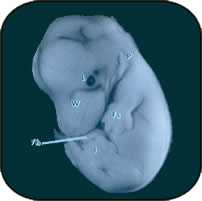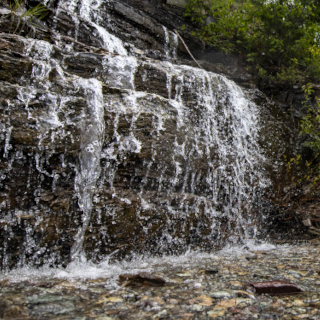Speciation in Shrews
Shrews (Order Insectivora) are considered to be the most primitive living placental mammals in the world. Members of the Family Soricidae also contain the smallest mammals in the world. For both of these reasons these species are incredibly unique; their embryonic/fetal development is, in many respects, more similar to that of marsupials than higher placentals and adult anatomical/ physiological parameters are at the physical limits for vertebrate systems [e.g., resting heart rate = 1,000 bpm, resting respiratory rate = 800 breaths/ min]. For these as well as other reasons, this group of mammal serves as an ideal model system with which to address significant questions in both evolutionary and developmental biology. We have been studying this group for the past 10 years. Our most recent focus concerns the effects of rapid environmental change on developmental stability in free living populations. Environmental stress can increase phenotypic variation in populations by affecting developmental stability of individuals. While such increase in variation results from individual differences in ability to buffer stress, groups of individuals and different traits may have different sensitivity to stressful conditions. On an individual level, stress induced variation in a trait may be related to the strength of stabilizing selection that acts on the trait. We experimentally examined sensitivity of mandibular development to stress in a free living population of 4 species of shrews. Alex Badyaev (below), with whom I have been collaborating on this research, is currently a Professor of Biology at the University of Arizona.


For more information on these studies refer to the following papers:
Foresman, K. R., and A. V. Badyaev. 2005. Developmental instability and the environment: why are some species better indicators of stress than others. In: Merritt, J. F., S. Churchfield, R. Hutterer, and B. A. Sheftel. (eds.). Advances in the biology of the shrews II. Carnegie Museum of Natural History, Special Publication No. XX., In Press.
Badyaev, A. V., Kerry R. Foresman, and Rebecca L. Young. Evolution of morphological integration: II. Developmental accommodation of stress-induced variation. American Naturalist, 2005. In Press.
Badyaev, A., and K. R. Foresman . 2004. Evolution of morphological integration. I. Functional units channel stress-induced variation in shrew mandibles. The American Naturalist, 163:868-879. (PDF)
Badyaev, A. V., and K. R. Foresman. 2000. Extreme environmental change and evolution: Stress induced morphological variation is strongly concordant with patterns of evolutionary divergence in shrew mandibles. Proceedings of The Royal Society: Biological Sciences. 267:371 377.
Badyaev, A. V., K. R. Foresman, and M. V. Fernandes. 2000. Rapid environmental change and developmental stability: vegetation removal causes increased fluctuating asymmetry in free living shrew populations. Ecology, 81:336 345.
Foresman, K. R. 1999. Distribution of the Pygmy Shrew, Sorex hoyi, in Montana and Idaho. Can. Field Nat., 113:681 683.
Foresman, K. R. 1997. The reproductive cycle of the vagrant shrew (Sorex vagrans) and the common shrew (Sorex cinereus) in Montana. Am. Midl. Nat., 139:108 113.
Foresman, K. R. 1994. Comparative embryonic development in the Soricidae. Pp. 241 258 in Proceedings of the International Colloquium on the Biology of the Soricidae, Special Publication, Carnegie Mus. Nat. Hist.
Foresman, K. R. 1992. A morphometric comparison of the Masked shrew (Sorex cinereus) and Hayden's shrew (Sorex haydeni) in Montana and bordering states. Northwest. Nat., 73:15 21.
